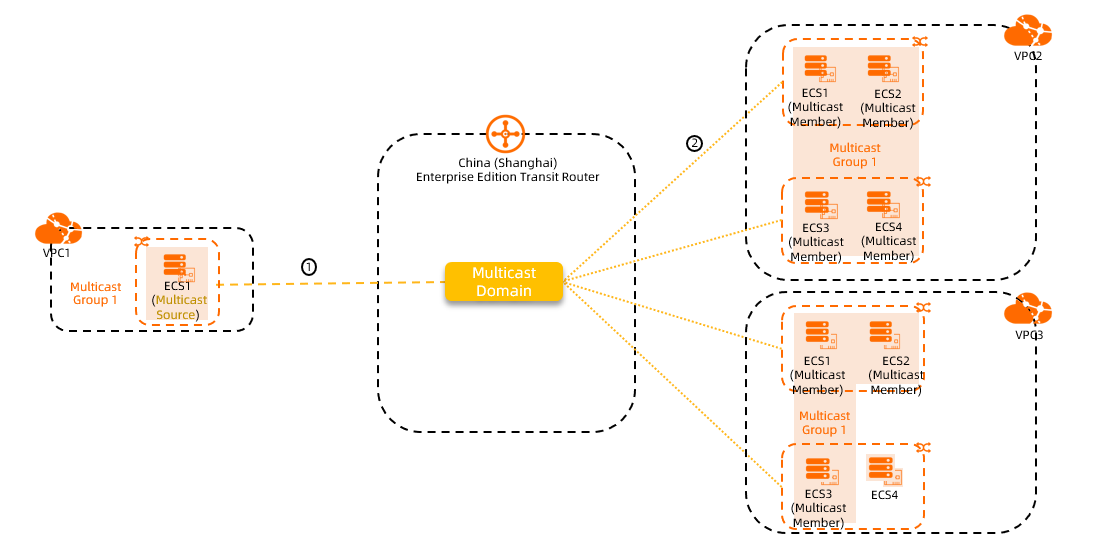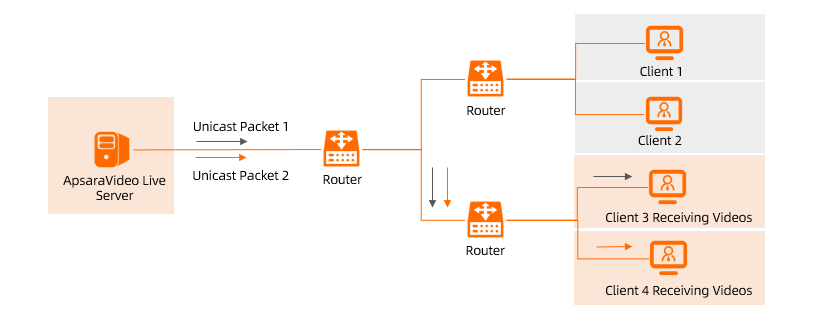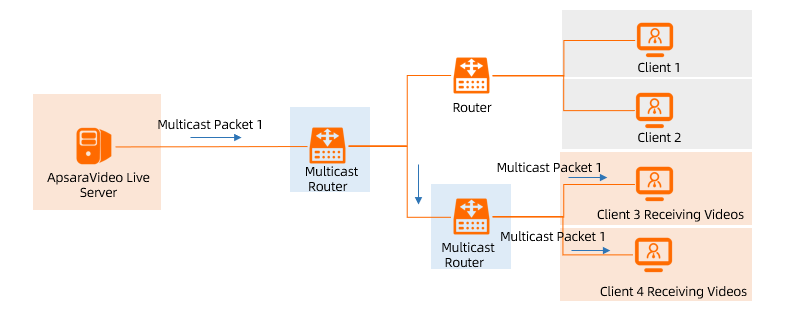Enterprise Edition transit routers support the multicast feature. After you connect an Enterprise Edition transit router to network instances, you can enable and manage multicast. The Enterprise Edition transit router also forwards multicast packets.
Background information
Features and advantages
This section describes the use scenarios, advantages, and terms of multicast.
Use scenarios
After you enable multicast for an Enterprise Edition transit router, you can create and manage multicast networks in the following scenarios:
Create a multicast network in a virtual private cloud (VPC), as shown in Multicast Network 3.
Create a multicast network among VPCs that are deployed in the same region, as shown in Multicast Network 2.
Create a multicast network among VPCs that are deployed in different regions, as shown in Multicast Network 1.

Advantages
Low Cost
The multicast feature supported by Enterprise Edition transit routers is a cloud-native multicast feature developed by Alibaba Cloud. This feature helps you build multicast networks without additional physical devices or third-party software licenses. Multicast can be activated based on your business requirements and is billed on a pay-as-you-go basis.
High Reliability
Enterprise Edition transit routers support zone-disaster recovery, which prevents single points of failure and improves the availability of your multicast network.
Easy Maintenance
Compared with traditional methods that use command-line interfaces (CLIs) for maintenance, Enterprise Edition transit routers simplify route configurations and multicast source and member management because CEN provides a visualized management console.
Terms
The following table describes the terms of multicast.
Term | Description |
Multicast domain | A multicast domain defines the scope of a multicast network in a region. Only resources in the same multicast domain can transmit or receive multicast packets. You can create multiple multicast domains on an Enterprise Edition transit router. The multicast domains in the same region are isolated from each other. Multicast groups in multicast domains that are created in different regions can communicate with each other if the multicast groups have the same multicast IP address. |
Multicast group | A multicast group consists of resources that transmit, replicate, and receive packets. A multicast group is identified by its IP address.
|
Multicast source | A multicast source in a multicast group transmits multicast packets. |
Multicast member | A multicast member in a multicast group receives multicast packets. |
Networking modes
You can create a multicast network through the static mode or the Internet Group Management Protocol (IGMP) mode.
The IGMP mode is available for whitelist users in beta testing.
Static mode: Manually create a multicast source and register members to build a multicast network after a domain is created.
IGMP mode: Allows hosts to dynamically join a multicast group and manage membership through IGMP after a domain is created.
As a part of the Internet protocol suite TCP/IP, IGMP is responsible for membership management of IPv4 multicast groups. When a host joins a multicast group of a transit router through IGMP, it becomes both a multicast source and a member. For more information, see IGMP for transit router (beta testing).
For more information about how to create a multicast network, see Create and manage a multicast network.
Billing
After you enable multicast on an Enterprise Edition transit router, you are charged connection fees, data forwarding fees, and inter-region connection fees based on your network topology. For more information about the billing rules for connections and inter-region connections, see Billing rules.
The following section describes the billing rules for data forwarding in multicast scenarios.
Billing rules
Data forwarding is billed on a pay-as-you-go basis. With a billing cycle of 1 hour, a bill is generated every hour. Partial hours are billed as full hours.
Data forwarding fee = Amount of data transfer × Unit price of data transfer (USD0.02/GB)
The data transfer consists of the following items:
The total amount of data that each multicast source transmits to the Enterprise Edition transit routers.
The total amount of data that the Enterprise Edition transit routers forward to the multicast members.
Billing examples

The preceding figure shows how data forwarding is billed. As shown in the preceding figure, the Elastic Compute Service (ECS) instances in VPC1, VPC2, and VPC3 are added to Multicast Group 1. ECS1 in VPC1 is the multicast source, and the ECS instances in VPC2 and VPC3 are the multicast members. When the Enterprise Edition transit router forwards data, you are charged for two billable items, as described in the following table.
Billable item | Description |
① | The total amount of data transferred from the multicast source to the Enterprise Edition transit router. |
② | The total amount of data that the Enterprise Edition transit router forwards to ECS1, ECS2, ECS3, and ECS4 in VPC2, and to ECS1, ECS2, and ECS3 in VPC3. |
Assume that Billable Item ① is 2 GB and Billable Item ② is 8 GB.
Data forwarding fee = (2 + 8) GB × USD 0.02/GB = USD 0.20.
Limits
Multicast is supported by Enterprise Edition transit routers only in the following regions: China (Hangzhou), China (Shanghai), China (Beijing), China (Ulanqab), China (Shenzhen), China (Chengdu), China (Hong Kong), Japan (Tokyo), Singapore, Germany (Frankfurt), UK (London), US (Virginia), and US (Silicon Valley).
Enterprise Edition transit routers support multicast only for VPCs.
The elastic network interfaces (ENIs) created by Enterprise Edition transit routers in VPCs cannot be added to multicast networks.
An elastic network interface (ENI) can be a multicast source and a multicast member in the same multicast group.
Only the primary private IP address of an ENI can be used as a multicast object. Other IP addresses of the ENI do not support multicast.
The following table describes the quota limits on each multicast resource.
Item
Default value
Adjustable
The maximum number of multicast domains supported by a transit router
20
No
The maximum number of multicast domains that each VPC can associate
NoteThe total number of multicast domains associated with all vSwitch in each VPC cannot exceed the quota.
20
The maximum number of multicast sources and group members supported by each transit router
2,000
You can use one of the following methods to increase the quota:
Request a quota increase on the Quotas page in the CEN console. For more information, see Manage CEN quotas.
Request a quota increase in the Quota Center console. For more information, see Submit an application to increase a quota.
The upper limit for manual adjustment is 3,000. If you require more, contact your account manager. The maximum is 10,000.
The maximum number of multicast members in each multicast group in a transit router
100
No
The maximum number of multicast sources in each multicast group in a transit router
100
The maximum number of vSwitches that each multicast domain can associate with in a transit router
10
The maximum number of cross-region multicast members that each group can register a transit router
15
The maximum number of multicast groups supported by a multicast domain
20 (Closing down)
The maximum bandwidth of a multicast group
NoteThe bandwidth refers to the sum of the bandwidth that the multicast sources use to transmit packets to the multicast group and the bandwidth that the multicast group uses to transmit packets to the multicast members.
10 Gbps
The multicast feature cannot be disabled after it is enabled. It does not impact your existing features.


